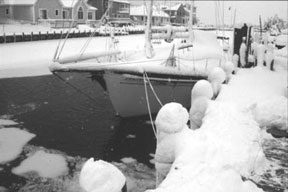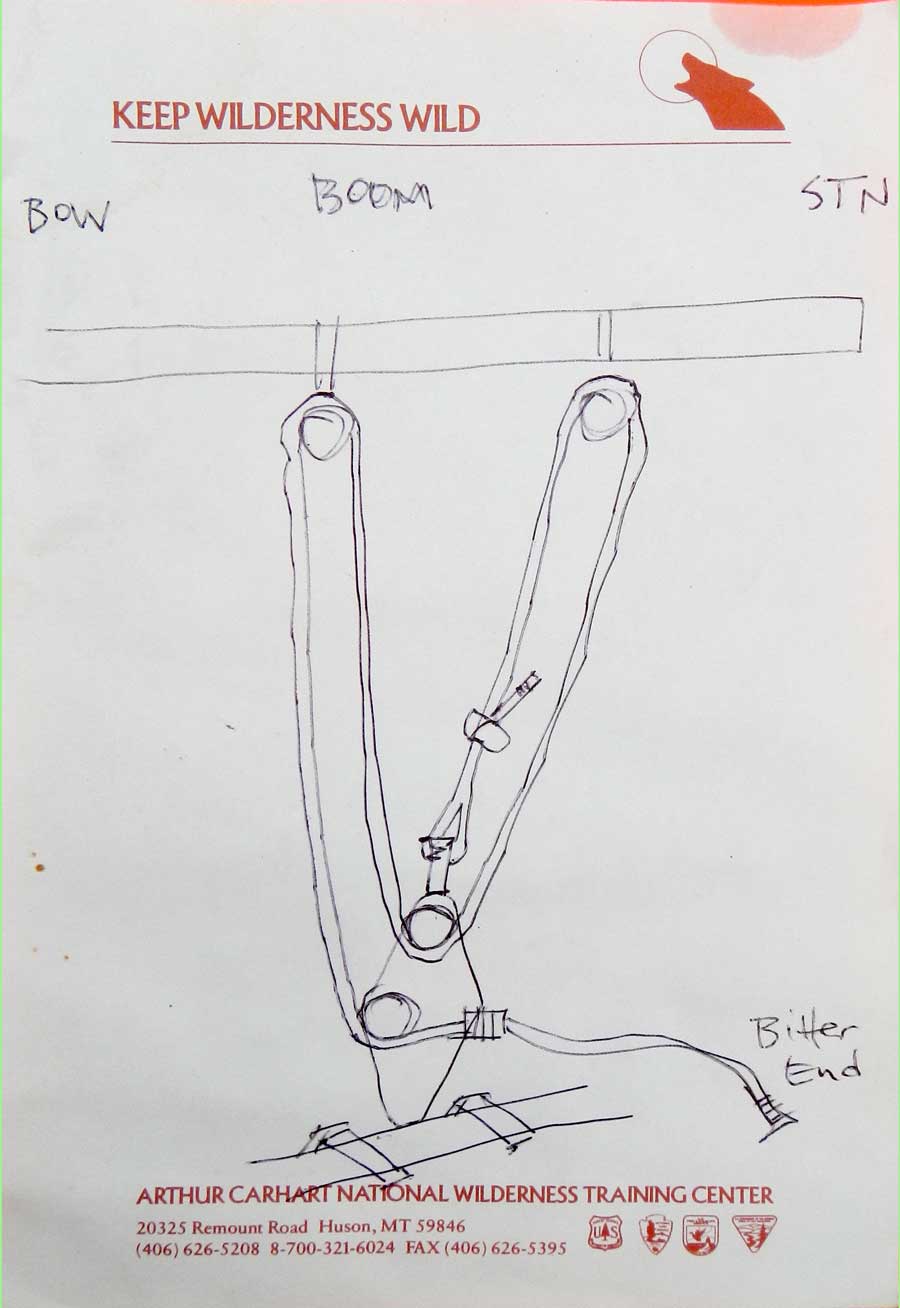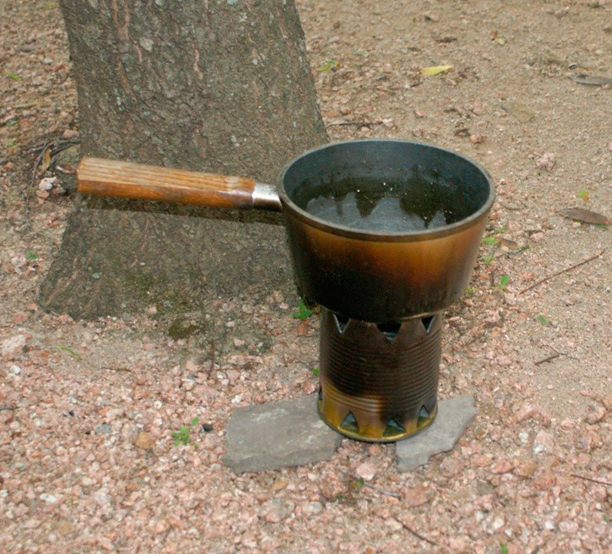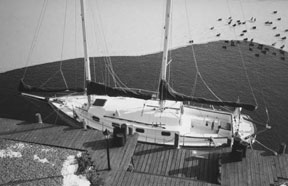
Mid-winter photo of the author’s schooner, Delphinus, at the dock next to his home in New Jersey. His boat is protected from ice around the hull by a water-agitation motor.
Solving the problem of icing up in winter
For those of us who live in the higher latitudes, the approach of the fall season reminds us of an upcoming conflict between our boating agendas and the impending deep freeze. For a fortunate few, this means stowing those summer clothes on board and sailing toward warmer climates. But most of us will make arrangements at the local marina for a haulout and winter cover or possibly for wet (in-the-water) storage. Those who have their homes on the banks of navigable water and have their boats moored at their own docks or at the community dock of a condominium have yet another option: wintering their boat in the water at her normal location near home. This option requires appropriate preparation and equipment, of course.
One of the problems with wet storage in latitudes where the surface of the water can freeze solid during the winter is the potential problem of ice damage, unless proper precautions are taken.

If needed, an agitation motor can be canted at an angle
With wooden hulls, water getting between the planks can freeze, spreading them apart and allowing more water to enter and re-freeze until a major leak (and possible sinking) occurs.
The problems are usually less threatening with fiberglass boats. However, when thick ice forms around the hull of any boat, damage to the rudder and prop is possible. Also, when a boat is surrounded by ice, wind and current will cause it to rock and pitch. The resultant grinding action of ice against the hull can cut away at the gelcoat along the waterline of a fiberglass boat. This can result in water incursion into the laminate and, at the very least, an additional gelcoat repair job in the spring. With wood boats, ice can wear through the paint and gouge the hull. Depending on the waterline hull shape, major structural damage is possible. For all of these reasons it’s important to prevent ice from forming around a boat that spends the winter in the water.
To make sure the boat is floating in above-freezing water, a water de-icing system in the winter is the answer. These systems are just as practical for an individual boat at a private dock as they are for a large marina. For those who live where the waters freeze during the winter, the “bubbler” and underwater agitation-motors are a familiar sight, but how do they keep the water from freezing around our boats?
Properties of water
The designer of our world certainly gave us a great gift when the physical properties of water were promulgated. Water, one of the most commonplace and familiar of all natural substances, is one of the most remarkable. Compared with nearly every other substance, water behaves, physically, in a unique manner.

Ice eater by The Power House
Nearly every other material expands when heated and contracts when cooled, but water follows this pattern only in part. As it is cooled down to about 39° F it does indeed contract; but with further cooling it begins to expand again, and when it begins to freeze this expansion is dramatic.
Let’s imagine what would happen if water did not follow this aberrant behavior. If water and ice continued to contract, as does nearly every other substance, ice would be denser and heavier than water. As ice formed at the cold interface of water and air, it would sink to the bottom.
Other layers of ice would also sink as they formed, until the entire body of water would be frozen solid. Since sunlight and heat don’t penetrate very deeply into a body of water or ice, none of our lakes, streams and bays in the northern latitudes would ever thaw out in the summertime, except to a slight depth at the surface. Fish and nearly all forms of aquatic and bottom-life could not survive, and our northern bays, lakes, and streams would be useless as a food source, for recreation, or navigation.
When a body of fresh water is cooled, it gradually contracts and becomes denser and heavier until it reaches 39° F. Then it begins to expand as it’s cooled to the freezing point and is transformed into ice at 32° F or less. Although the temperatures given in these explanations are for fresh water, salt water follows a similar pattern. In the case of salt water, the exact temperatures at which these events happen are determined by the water’s salinity.
A solution of salt water freezes at a lower temperature than fresh water. In fact, the freezing point of a saturated solution of salt water is about 6 degrees C, whereas the freezing point of unsaturated ocean water (depending on salinity) is around 21 degrees F.
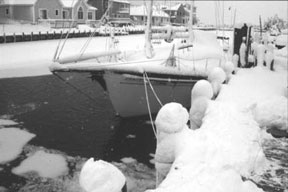
Agitator motor suspended at an angle at the author’s dock.
Since surface water cooled to 39° F becomes denser, it sinks to the bottom. It is then replaced by warmer bottom water, which then follows the same scenario. Thus no ice can ever be formed on the surface of a body of fresh water until the whole body of water is cooled to 39° F.
This means that the water at the bottom of a deep-frozen lake is near 39° F whatever the temperature of the air above the ice. De-icing systems take advantage of this physical fact of nature, using this huge reservoir of “warm” water at the bottom for their supply of de-icing water.
Bringing water up
The two popular methods of raising this bottom layer of water to the surface are the air-bubbler system and the propeller-agitator.
With the air-bubbler, a weighted, perforated hose is laid along the bottom and connected to an air compressor (controlled by an air thermostat). The rising air bubbles coming out of the hose carry along with them the above-freezing water from the bottom, creating an area of unfrozen water above the bubbler hose.
The propeller-agitator accomplishes the same result by using a hermetically sealed electric motor with a propeller attached. These agitator units are also controlled by air thermostats. Naturally, the deeper the water at the slip, the larger the reservoir of warmer water and the more practical the de-icing system.
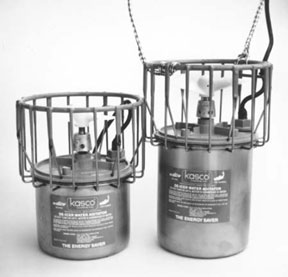
Kasco’s agitation unit
A bubbler system can be used equally well for an individual boat or a huge marina with the physical size of the compressor and its horsepower dependent on the length of the bubbler hose and depth of the water. Originally these compressors were quite noisy and could be annoying in a residential environment. In recent years, however, internal as well as external sound-proofing and state-of-the-art compressor design has nearly eliminated this problem. During the winter, compressors usually live at dockside and must be in a location well above any possible flooding.
The underwater agitation motor is completely quiet, except for the rippling noise of the water. If depth is sufficient, the underwater motor can be hung directly beneath the boat. Alternately, it can be hung at an angle off the side of the boat where the water is deepest, or at the bow facing aft. These motors can be suspended by their own ropes, mounted to a rigid arm, or suspended from a flotation unit. Most manufacturers of agitator motors have optional dock or piling mounts and flotation-mounting kits. When the underwater motors are mounted in the vertical position, these units produce a circular pattern of unfrozen water. When suspended at an angle, the pattern is elongated.
Adjusting the angle of a rope-suspended motor is done by simply looping one of the suspension ropes back one or two ribs on the propeller cage or through one of the off-center holes in the housing placed there for that purpose. These underwater motors have plastic propellers and replaceable zinc anodes for electrolysis reduction and are available in 1/2-, 3/4-, and 1-hp sizes, depending on the size of the area to be de-iced and the severity of the winters. Originally, the motor cases were filled with oil, but recently synthetic dielectric lubricating fluids that are non-toxic, biodegradable, and non-bioaccumulating have been introduced.
Bags and debris
Although it would be nice if our waters were pristine, unfortunately underwater plastic bags and other debris are a fact of life. If a de-icing system is used in an area where large amounts of such things are present, the chance of their fouling the propeller of an underwater motor must be taken into account when selecting a de-icing system. Naturally, underwater debris presents no problem to a bubbler system.
If you’re using a propeller-agitation system, the following practices are recommended:
- It is usually easier to de-ice a boat by installing the de-icer at the bow and pushing the water toward the stern, since boats are designed for easiest water-flow in that direction.
- If a boat is berthed in a river, de-icing from the upstream side will allow the current to help, rather than hinder.
- When a boat is wintering next to a bulkhead, the motor can be hung off the free side and canted toward the hull.
Obviously neither type of de-icing system can possibly prevent ice around a boat if the ice is being moved by wind or current.
Other considerations
De-icing systems are also very effective in preventing damage to pilings and docks in tidewater locations. In these locations, when ice freezes solid around a piling, the piling is frequently lifted inch by inch at each tide change. This results in expensive dock and piling repairs or replacements, come spring. Unfrozen water around the pilings can prevent this costly problem, and marinas often use bubbler systems in their slips whether or not any boats are present. This lifting or “jacking” damage is also common in the lakes, where weather, wind, and changes in lake levels can cause the same thing to happen.
Although we only think of water agitation systems for boating use, they are also used as aeration units in fish farms. A spectacular and bizarre use of a motor/agitator made world news when, in October 1988, whales trapped by ice at Barrow, Alaska, were kept in an ice-free area until Russian and U.S. icebreakers could open a path for them to open water.
Even though de-icing systems eliminate most of the problems associated with wintering in the water, some other things to consider are the possibility of freezing problems inside the hull. The relatively warm bottom water surrounding the hull typically will keep the bilge free of ice, but in harsh northern climates there’s no guarantee. Where electricity is available, many boatowners use electric light bulbs or small heating elements inside the engine compartment to help keep the packing glands around the prop shaft and rudder shaft, as well as the cockpit drains, from freezing. Small, inexpensive, plug-in thermostats are also available so the heat is not on during warm spells.
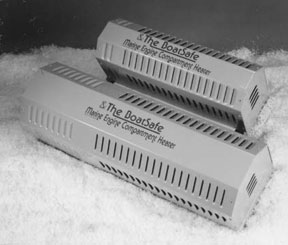
BoatSafe: Bensaco’s engine compartment heater
Light-bulb problems
People who use a light bulb for heat can encounter several problems. A normal light bulb has a life expectancy of about 750 hours. This means that if left on continuously, it will last about a month – not nearly long enough to last through the winter. A long-life bulb, which puts out the same amount of heat, but less light, has a more rugged filament and less chance of burning out over the winter. It’s also much less vulnerable to vibrations. An outdoor bulb should be used if there is any possibility of water dripping on it. The problem with light bulbs, in general, is that the very limited amount of heat generated is only effective within a very confined space and where winter temperatures are relatively mild.
There have also been cases where an exposed bulb has come in contact with flammable material or has shattered and caused a fire. Marine-grade engine-compartment heaters are a far better and safer way to go. These come in several styles and wattages. Some of these heaters have their own built-in thermostats and circulating fans and are in stainless-steel or aluminum cases.
Other items to check before in-the-water winter storage, are the condition of your automatic bilge pump and supply of power. Is the float-switch free of debris? Can the pump be left in a standby mode without leaving the main 12-volt battery switch on for the rest of the boat? Is there a possibility of the bilge freezing, rendering the float-switch inoperable? Can the batteries remain in a charged – but not overcharged – state by use of a “smart” battery-charger or trickle-charger? Have you added non-toxic anti-freeze to the bilge and pumped it through the bilge-pump and discharge hoses? Other than the cockpit drains, are the through-hull seacocks closed? Ice can lift off a hose. While you’re at it, now is a good time to see if those hoses are double-clamped and the clamps and hoses are in good condition.
Even though you have done all the winterization tasks properly, an occasional mid-winter visit inside the cabin is always a good idea to make sure everything is OK – if only to assure your boat and yourself that there are warm breezes and sunny days to come. After your checkout, a half hour curled up on the settee with your hands wrapped around a hot cup of coffee as you plan those summer cruises can be great therapy in relieving the depression of those cold gray days of winter as you wait for spring to creep north to reclaim the shoreline.
Resources: Manufacturers of propeller-agitation units:
Kasco Marine, Inc. 800 Deere Road Prescott, WI 54021 800-621-7611 http://www.de-icer.com
Follansbee Dock Systems Follansbee, WV 26037 800-223-3444 http://follansbeedocks.com
Manufacturer of bubbler de-icing systems: World Wide Enterprises 19 Cedar St. East Falmouth, MA 02536 508-540-0963 http://www.worldwideent.net
Pyramid Technologies LLC 45 Gracey Ave. Meriden, CT 06451 877-453-8669 http://www.pyramidtech.com
The Power House, Inc. 20 Gwynns Mills Court Owings Mills, MD 21117 800-243-4741
Manufacturer of engine compartment heaters: Bensaco, Inc. 3301 Myrtle St. Edisto Beach, SC 29438 800-969-3785

